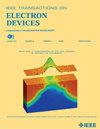了解用交流输出电导法测量先进 FinFET 节点的自发热效应
IF 2.9
2区 工程技术
Q2 ENGINEERING, ELECTRICAL & ELECTRONIC
引用次数: 0
摘要
准确测定热阻并给出清晰的物理解释,对于分析块状 FinFET 的自热效应 (SHE) 和确保电路可靠运行至关重要。在本文中,我们使用了大量电热模拟,并根据实验进行了校准,以验证一种基于测量的交流输出电导监测 SHE 的常用方法。结果证实,与块状硅相比,纳米级硅翅片的热传导率有所下降。然后,我们探讨了输出电导法提取的温度与鳍片内部最高温度(这是研究器件可靠性的有用参数)之间的关系,并将其作为器件偏置和尺寸的函数,提供了一些对缩放技术节点的预测。我们的结果表明以下几点是成立的:1) 用交流输出电导法提取的超温代表了整个器件有效区域的平均超温;2) 交流电导法在很大程度上低估了长沟道器件的峰值温度,而对短沟道器件的低估则较少。不过,在后一种情况下,上述温度之间的差异会随着栅极电压的变化而发生明显变化。本文章由计算机程序翻译,如有差异,请以英文原文为准。
Understanding the Self-Heating Effects Measured With the AC Output Conductance Method in Advanced FinFET Nodes
Accurate determination of thermal resistances having a clear physical interpretation is crucial for analyzing self-heating effects (SHEs) in bulk FinFETs and ensuring reliable circuit operation. In this article, we use extensive electrothermal simulations, calibrated against experiments, to validate a popular method to monitor SHEs based on the measured AC output conductance. The results confirm that nanoscale silicon fins exhibit degraded thermal conductivity compared with the bulk silicon case. Then, we explore the relationship between the temperature extracted by the output conductance method and the maximum temperature inside the fin (which is a useful parameter to study device reliability) as a function of device bias and dimensions, providing a few projections toward scaled technology nodes. Our results show that the following hold: 1) the overtemperature extracted with the AC output conductance method represents an average overtemperature across the device active area and 2) the AC conductance method largely underestimates the peak temperature of long-channel devices; less so for short-channel ones. In this latter case, however, the difference between the above temperatures changes appreciably as a function of gate voltage.
求助全文
通过发布文献求助,成功后即可免费获取论文全文。
去求助
来源期刊

IEEE Transactions on Electron Devices
工程技术-工程:电子与电气
CiteScore
5.80
自引率
16.10%
发文量
937
审稿时长
3.8 months
期刊介绍:
IEEE Transactions on Electron Devices publishes original and significant contributions relating to the theory, modeling, design, performance and reliability of electron and ion integrated circuit devices and interconnects, involving insulators, metals, organic materials, micro-plasmas, semiconductors, quantum-effect structures, vacuum devices, and emerging materials with applications in bioelectronics, biomedical electronics, computation, communications, displays, microelectromechanics, imaging, micro-actuators, nanoelectronics, optoelectronics, photovoltaics, power ICs and micro-sensors. Tutorial and review papers on these subjects are also published and occasional special issues appear to present a collection of papers which treat particular areas in more depth and breadth.
 求助内容:
求助内容: 应助结果提醒方式:
应助结果提醒方式:


